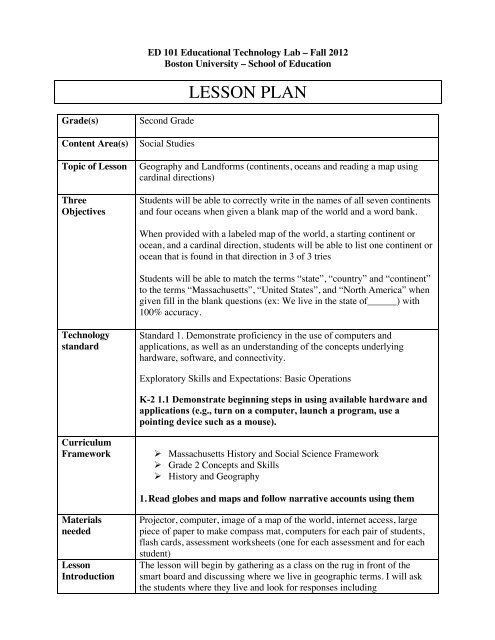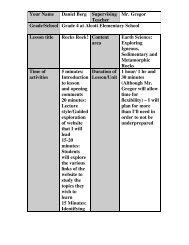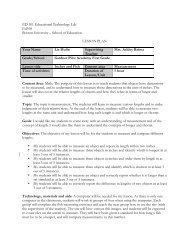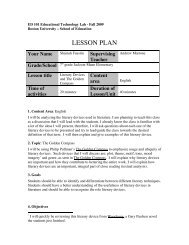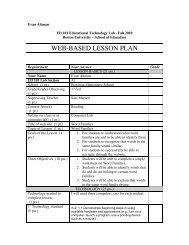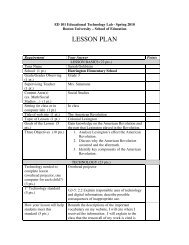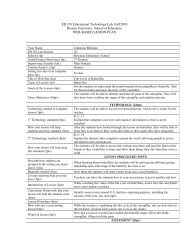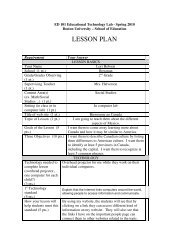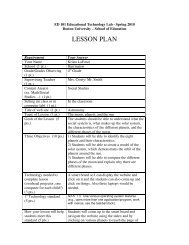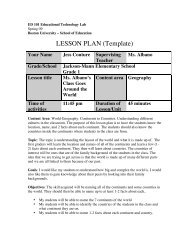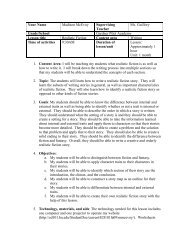LESSON PLAN - ED101 - Boston University
LESSON PLAN - ED101 - Boston University
LESSON PLAN - ED101 - Boston University
You also want an ePaper? Increase the reach of your titles
YUMPU automatically turns print PDFs into web optimized ePapers that Google loves.
ED 101 Educational Technology Lab – Fall 2012<strong>Boston</strong> <strong>University</strong> – School of Education<strong>LESSON</strong> <strong>PLAN</strong>Grade(s)Content Area(s)Topic of LessonThreeObjectivesSecond GradeSocial StudiesGeography and Landforms (continents, oceans and reading a map usingcardinal directions)Students will be able to correctly write in the names of all seven continentsand four oceans when given a blank map of the world and a word bank.When provided with a labeled map of the world, a starting continent orocean, and a cardinal direction, students will be able to list one continent orocean that is found in that direction in 3 of 3 triesStudents will be able to match the terms “state”, “country” and “continent”to the terms “Massachusetts”, “United States”, and “North America” whengiven fill in the blank questions (ex: We live in the state of______) with100% accuracy.TechnologystandardStandard 1. Demonstrate proficiency in the use of computers andapplications, as well as an understanding of the concepts underlyinghardware, software, and connectivity.Exploratory Skills and Expectations: Basic OperationsK-2 1.1 Demonstrate beginning steps in using available hardware andapplications (e.g., turn on a computer, launch a program, use apointing device such as a mouse).CurriculumFramework Massachusetts History and Social Science Framework Grade 2 Concepts and Skills History and Geography1. Read globes and maps and follow narrative accounts using themMaterialsneededLessonIntroductionProjector, computer, image of a map of the world, internet access, largepiece of paper to make compass mat, computers for each pair of students,flash cards, assessment worksheets (one for each assessment and for eachstudent)The lesson will begin by gathering as a class on the rug in front of thesmart board and discussing where we live in geographic terms. I will askthe students where they live and look for responses including
(5 minutes) “Massachusetts”, “United States” and “North America”.LessonProcedure, WebSite Use, andTechnologyStandardInstruction(15 minutes)After the lesson introduction, I will then ask if they know what geographicterm describes each of those locations and we will reach the informationthat they are respectively a state, country and continent. (2 minutes)I will then show the following video, projected on the smart board:http://www.brainpop.com/socialstudies/geography/continentsoftheworld/(1 minute)After our introductory discussion, I will pull up a map of the world on thesmart board. I will then ask students to identify any continents they know.If they cannot identify them all, I will identify those that remain. We willthen do the same with oceans (3 minutes for both continents and oceans).We will then discuss cardinal directions—North, East, South and West—and I will explain to them what they are. We will then play a game where Imake a mat of a compass and all of the students will start in the middle as Ithen tell certain students to stand in certain directions (ex: “If you’rewearing blue go to the North”) (3 minutes to play this).I will then assign them partners and they will then go to computers (eitherthe lab or laptop cart) and will go to my website(mmorgan2ed101.weebly.com) to learn and review more about geography.This is where I will integrate the technology standard as I will demonstrateon the board beforehand how to turn on a computer and launch the internetprogram and then in partners, they will need to turn on the computer, openthe browser and enter the URL. Doing this will demonstrate to me that theycan meet the standard. I will walk around and assist anybody who is havingdifficulty. The students will then be asked to explore the website, primarilythe pages titled “Where Do We Live?”, “Maps”, “Continents” and“Oceans” (6 minutes to explore the website)Wrap-Up ofLesson(5 minutes)How willstudents beassessed tomake sure theyare able toperform theobjectives?At the end of the lesson students will meet with a partner who is sittingacross from them and discuss what they learned. They will discusscontinents, oceans and cardinal directions with each other based on guidingquestions that will be posted on the board.Objective 1:Students will be able to correctly write in the names of allseven continents and four oceans when given a blank map of the world anda word bank.Assessment 1: Students will be given a map of the world and asked to fillin the names of the continents and oceans for homework and study it. Theywill also be given flashcards with a picture of each continent on them. Inclass they will play “around the world in small groups to practice namingthe continents. “Around the World” is a game in which a pair is shown aflash card and the student who correctly identifies it first moves on to thenext student to compete against them, attempting to make it through each
student without being beat. After this, they will be given a blank map andasked to fill it in independently with the names of the continents andoceans. There will be a word bank.Objective 2: Students will be able to identify what is found in a cardinaldirection of a continent (ex: North of Africa) when given a map of theworld and asked three questions with 100% accuracy.Assessment 2: As a class, we will practice our cardinal directions using amap and also using the classroom. I will ask students to sample questionssimilar to those on the test as a class. This will allow students to be familiarwith the directions. They will be given a worksheet with a labeled map ofthe world and asked three direction questions.Objective 3: Students will be able to match the terms “state”, “country” and“continent” to the terms “Massachusetts”, “United States”, and “NorthAmerica” when given fill in the blank questions (ex: We live in the stateof______) with 100% accuracy.Assessment 3: We will discuss in class these terms and their application towhere we live. For homework, students will be given a fill in the blankworksheet with three questions. (We live in the state of_______. We live inthe country _____________. We live on the continent_____________).


